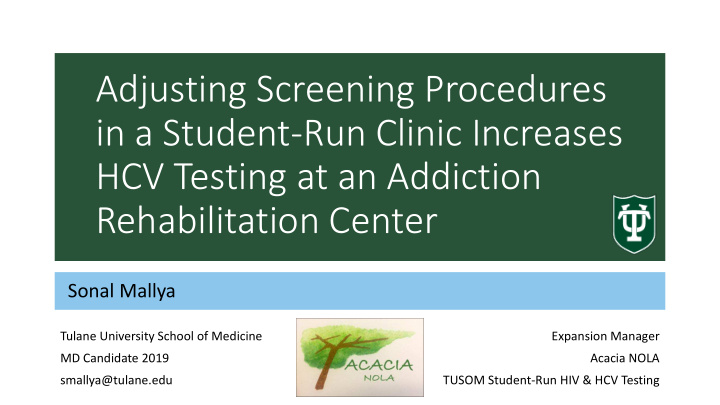



Adjusting Screening Procedures in a Student-Run Clinic Increases HCV Testing at an Addiction Rehabilitation Center Sonal Mallya Tulane University School of Medicine Expansion Manager MD Candidate 2019 Acacia NOLA smallya@tulane.edu TUSOM Student-Run HIV & HCV Testing
FINANCIAL DISCLOSURES This research was partially funded by a Gilead Frontlines of Communities in the United States (FOCUS) Grant
OBJECTIVE Changing Hepatitis C (HCV) screening patterns in a medical student-run testing program in order to impact the proportion of clients tested
HCV IN THE U.S. An estimated 2.7-3.9 million people with chronic hepatitis C virus (HCV) infection (CDC, 2017) HCV incidence increased 294% from 2010 to 2015, driven largely by injection drug use (CDC, 2017) The disenfranchised disproportionately test positive for HCV 15-25% of incarcerated 30% of homeless 70-80% of people who inject drugs
HCV IN NEW ORLEANS Louisiana has the highest incarceration rate in the nation/the world (in 2014, 816 per 100,000) 7000+ formerly incarcerated individuals return to Orleans Parish annually Homeless population fluctuates, but in 2014, 46.9 out of every 10,000 people in the city were homeless Opioid epidemic death rate is outpacing the murder rate in Orleans Parish This is why we should be testing! UMCNO has opt-out HCV testing in the ED* Physician-initiated risk and symptom-based testing was yielding a 17% positivity rate Can only capture those using healthcare
PROGRAM BACKGROUND Post Katrina March 2015 January 2016 • HIV screening • Initial grant • HCV introduced allows for screening into Tulane HCV expanded to 6 student-run screening at additional clinics (2008) single sites including homeless homeless shelter shelters, rehabilitation centers, and community clinics
INITIAL PROGRAM STRUCTURE (1/2016) Approximately 25 active testers Each volunteering one shift per month Testers used state-mandated tuberculosis (TB) PPD testing as a point of access to the client population by offering voluntary HIV and HCV testing afterwards Patients who tested positive linked to care
IMPROVEMENT PROCESS • Better track client • Qualtrics survey, slow information via roll out in August 2016 electronic data collection Plan Do Act Study • Refined the flow of • Testers took time to questions multiple adapt to combined times as testers paper-based HIV data pointed out flaws and collection with redundancies electronic HCV data collection
MALE REHAB CENTER #2 Male addiction rehabilitation program in New Orleans that houses approximately 85 clients Treats both behavioral and substance addictions Clients may enter the six-month program voluntarily or by court order Clients are state mandated to receive TB screening during the first week of their stay HIV testing had been present for at least one year when HCV testing introduced in January 2016
DEMOGRAPHICS (*p<0.5, **p<0.1)
IMPROVEMENT PROCESS • Expanded testing • Remove backlog at hours MRC2 by testing all clients within first week Plan Do Act Study • Initial backlog • Combined TB and removed in 4 weeks, HIV/HCV testing, so but additional changes client was in same room, needed to sustain with same tester testing rate
PRINCIPAL FINDINGS Avg = 9.65/mo
POLICY & PRACTICE Proper screening for HCV in disenfranchised populations and subsequent access to care is the first step in alleviating the burden of disease Maximizing screening in this population is an important opportunity to counsel those who may be HCV negative but are at high risk of contracting HCV Integrating HCV testing into other intake procedures seems to have a positive impact on testing rates
AKNOWLEDGEMENTS Clients & patients Student volunteers
CITATIONS Klinkenberg WD, Caslyn RJ, Morse G a, et al. Prevalence of human immunodeficiency virus, hepatitis B, and hepatitis C among homeless persons with co-occurring severe mental illness and substance use disorders. Compr Psychiatry. 2003;44(4):293-302. doi:10.1016/S0010-440X(03)00094-4. Strehlow AJ, Robertson MJ, Zerger S, et al. Hepatitis C among clients of health care for the homeless primary care clinics. J Health Care Poor Underserved. 2012;23(2):811-833. doi:10.1353/hpu.2012.0047. Viner K, Kuncio D, Newbern EC, Johnson CC. The continuum of hepatitis C testing and care. Hepatology. 2015;61(3):783-789. doi:10.1002/hep.27584. Kamarulzaman A, Reid SE, Schwitters A, et al. Prevention of transmission of HIV, hepatitis B virus, hepatitis C virus, and tuberculosis in prisoners. Lancet. 2016;388(10049):1115-1126. doi:10.1016/S0140-6736(16)30769-3. Zucker DM, Choi J, Emily R. Mobile Outreach Strategies for Screening Hepatitis and HIV in High-Risk Populations. Public Health Nurs. 2011;29(1):27-35. doi:10.1111/j.1525-1446.2011.00970.x. Ward JW. The hidden epidemic of hepatitis C virus infection in the United States: occult transmission and burden of disease. Top Antivir Med. 2013;21(1):15-19. Chak E, Talal AH, Sherman KE, Schiff ER, Saab S. Hepatitis C virus infection in USA: An estimate of true prevalence. Liver Int. 2011;31(8):1090-1101. doi:10.1111/j.1478-3231.2011.02494.x. Chang, C.,, Louisiana is the world’s prison capital. The Times -Picayune. May 13, 2012: New Orleans, LA Hasselle D. and Woodward A., Young and homeless in New Orleans, in The Gambit 2015: New Orleans, LA http://www.umcno.org/Newsletter/ViewNewsletterNoMaster.aspx?x=YTn6r2ViapMciKY/1Ucp2A==#nolaknows Lipinkski, J., New Orleans' drug-related deaths exceed murders in 2016, in The Times-Picayune2017: New Orleans, LA.
APPENDIX Disparities and Health Equity Monday, 6:30-8:00pm
APPENDIX Disparities and Health Equity Monday, 6:30-8:00pm
APPENDIX Disparities and Health Equity Monday, 6:30-8:00pm
APPENDIX
Recommend
More recommend